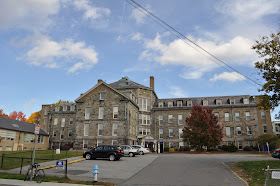"Poverty Plain", people used to call the area. Located on "the most remote corner of Cambridge" where the city of Cambridge, Somerville and Arlington adjoin, the former Cambridge Poor Farm is now utilized as the International School of Boston.
I regard the location now as desirable because I'm a proud North Cambridge resident, but the city threw everything deemed undesirable, including a tannery, to this area. The almshouse for "orphans, paupers, the elderly, and the insane" was built in 1851. The mix of the population astonishes me but it was the norm of the time.
The farm was indeed a self-supporting community where they acquired the food from their farms and fishing rights from a nearby Alewife Brook. I must confess that considering from the current state of the stream, it is little hard to imagine this used to be a source of the Alewife herring.
Alewife Brook
Alewife Brook, too
The building is constructed by the stone blocks from a ledge in the property -- I guess it's a current site of a high school athletic field. The architectural style heavy on stone reminded me and Brian about the Hôtel-Dieu de Montréal, the oldest hospital in Montreal. Is it a coincidence that the building now houses a bilingual school for French and English?
Rev. Louis Dwight and Gridley J. F. Bryant, both avid prison reformers, designed the building. Bryant also designed Washington Tower and Bigelow Chapel at Mt. Auburn cemetery. The octagonal rotunda functioned as a space for supervision, also separating the wards for men and women apart. This reminds me a panopticon, a type of prison building invented by Jeremy Bentham in 1785. He aimed for the efficient surveillance system with little effort -- the inmate begins to control himself, being aware of the unseen eyes from the central tower -- through the architectural design.
Aerial view of the building: it resembles a cross
It was lunch time. Students were hanging around on the roundabout with brown bags, chatting, eating lunch with friends. It was a gorgeous Autumn day, their hair was reflecting the bright light, oh, youth!
....
Recently, I met a woman who spent
For example, she needed to go through a lengthy procedure to take a shower, even though her room was right next to the shower room. Once she is in the shower room, alone, they locked her in from outside. A simple act of taking a shower (and the vital act for a teenager girl!) becomes an enduring task...Friends she met at Gaebler were the only good things she can think about. But the negative memories exceed the good ones with friends.
Aerial view of Gaebler
On the other hand, she is afraid that the demolition also means people are forgetting, or actively trying to erase the memory about the children of Gaebler. Demolishing a building is dead easy, but irreversible. She wanted the building converted to something rather than destroying it. I asked:
"What kind of conversion did you wish, like condos like the Metropolitan State, or a museum about the school?"
"No, I wanted the building converted to something like a school...a school for kids..."
Do you mean a school like this? Looking at the smiling students on the lawn, I was questioning her and myself in my mind.
*For more story about this courageous woman, please read: Gaebler Chiledren's Center, Waltham
Would you like to know more about the Poor Farm? Visit my follow-up article: Examining the Cambridge Poor Farm 1-2.
Locate Cambridge Poor Farm @ Google Map
A life in Gaebler in the mid 70's: Gaebler, Hell and Back
Click picture to enlarge
Click picture to enlarge











No comments:
Post a Comment